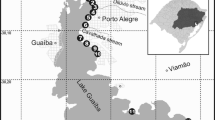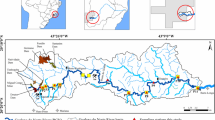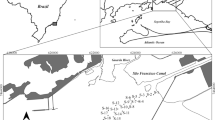Abstract
Sediment and porewater samples from an enclosed bay receiving stormwater discharge (Skutviken) near the centre of Luleå, northern Sweden were analysed for major and trace elements and 16 polycyclic aromatic hydrocarbons (PAHs). Among the studied metals Cd, Cu, Pb and Zn were enriched at Skutviken. Also, the PAH content was enriched, in particular for phenantrene, anthracene, fluoranthene and pyrene which are regarded as common constituents in stormwater. The use of trace metal ratios provided indications about pollutant sources for the sediment. Cs-137 dating was used to determine historical changes in metal and PAH fixation in the sediment. The bay Skutviken is enclosed through the construction of a road bank since 1962. The enclosure led to reduced water circulation in the bay that promotes the occurrence of anoxic conditions with sulphate reduction within the bay. As a consequence of these conditions, metals are trapped in the sediments as sulphides. This study suggests that enclosed bays with restricted water circulation may be efficient traps for urban pollutants, reducing the present-day input of pollutants to the sea. In areas with postglacial land uplift, where such bays are common, bay sediments are a potential future source of pollutants when uplift results in erosion and oxidation of the sediments.











Similar content being viewed by others
References
Appleby, P. (2002). Chronostratigraphic Techniques in Recent Sediments. In W. M. Last & J. P. Smol (Eds.), Tracking environmental change using lake sediments. Vol. 1, Basin analysis, coring, and chronological techniques (pp. 171–203). Dordrecht: Kluwer.
ATSDR (1995). Toxicology profiles for polycyclic aromatic hydrocarbons. Agency for Toxic Substances and Disease Registry, US Departement of Health and Human Services, Atlanta, GA
Brown, J. N. (2002). Partitioning of chemical contaminants in urban stormwater. Dunedin, New Zealand: University of Otago.
Brown, J. N., & Peake, B. M. (2006). Sources of heavy metals and polycyclic aromatic hydrocarbons in urban stormwater runoff. The Science of the Total Environment, 359, 145–155.
Budzinski, H., Jones, I., Bellocq, J., Piérard, C., & Garrigues, P. (1997). Evaluation of sediment contamination by polycyclic aromatic hydrocarbons in the Gironde estuary. Marine Chemistry, 58, 85–97.
Canfield, D. E., Thamdrup, B., & Hansen, J. W. (1993). The anaerobic degradation of organic matter in Danish coastal sediments: Iron reduction, manganese reduction, and sulfate reduction. Geochimica et Cosmochimica Acta, 57, 3867–3883.
Charlesworth, S. M., & Lees, J. A. (1999). The Transport of particulate-associated heavy metals from source to deposit in the urban environment, Coventry, UK. The Science of the Total Environment, 235, 351–353.
Davison, W. (1993). Iron and manganese in lakes. Earth Science Reviews, 34, 119–163.
Ebbing, J., Zachowicz, J., Uscynowicz, S., & Laban, C. (2002). Normalization as a tool for environmental impact studies: the Gulf of Gdansk as a case study. Baltica, 15, 49–62.
Endlicher, W. (2004). Die Stadt als natürliches System. Berliner Geografische Arbeiten, 97, 33–38.
Endlicher, W., & Simon, U. (2005). Editorial: Perspectives of Urban Ecology—The Metropolis of Berlin as a Natural and Socioeconomic System. Die Erde, 136, 97–102.
Erixon, P. (1996). Luleå innerfjärdar: rapport A: Vattenkvalitet, bottenkvalitet, vegetation. Luleå, Högskolan i Luleå. Avdelningen för ekologi och miljövård.
Evans, K. M., Gill, R. A., & Robotham, P. W. J. (1990). The PAH and organic content of sediment particle size fractions. Water, Air, and Soil Pollution, 51, 13–31.
Gocht, T., Moldenhauer, K.-M., & Püttmann, W. (2001). Historical record of polycyclic aromatic hydrocarbons (PAH) and heavy metals in floodplain sediments from the Rhine River (Hessisches Ried, Germany). Applied Geochemistry, 16, 1707–1721.
Gonzalez, A., Moilleron, R., Chebbo, G., & Thévenot, D. R. (2000). Determination of polycyclic aromatic hydrocarbons in urban runoff samples from the “Le Maraisâ” experimental catchment in Paris centre. Polycyclic Aromatic Compounds, 20, 1–19.
Hauer, F. R., & Lamberti, G. A. (2006). Methods in stream ecology. Amsterdam: Elsevier.
Hernebring, C. (1996). Snösmältningspåverkan på avloppssystem inom urbana områden (Snowmelt Induced Runoff in Sewer Systems). Stockholm, Sweden: VA-Forsk, Swedish Water and Wastewater Association (VAV).
Hirst, D. M. (1962). The geochemistry of modern sediments from the Gulf of Paria–I The relationship between the mineralogy and the distribution of major elements. Geochimica et Cosmochimica Acta, 26, 309–334.
Hvitved-Jacobsen, T., & Yousef, Y. A. (1991). Highway Runoff Quality, Environmental Impacts and control. In R. S. Hamilton & R. M. Harrison (Eds.), Highway pollution. Netherlands: Elsevier.
Hübinette, H. (1998). Närsaltläckage från Björsbyfjärdens avrinningsområde. Luleå, Sweden: Luleå University of Technology.
Ilus, E., & Saxén, R. (2005). Accumulation of Chernobyl-derived 137Cs in bottom sediments of some Finish lakes. Journal of Environmental Radioactivity, 82, 199–221.
Karlsson, K., & Viklander, M. (2008a). Polycyclic aromatic hydrocarbons (PAH) in water and sediment from gully pots. Water, Air, and Soil Pollution, 188, 271–282.
Karlsson, K., & Viklander, M. (2008b). Trace metal composition in water and sediment from catch basins. Journal of Environmental Engineering, 134, 870–878.
Kayhanian, M., Stransky, C., Bay, S., Lau, S. L., & Stenstrom, M. K. (2008). Toxicity of urban highway runoff with respect to storm duration. Science of The Total Environment, 389, 386–406.
Krein, A., & Schorer, M. (2000). Road runoff pollution by polycyclic aromatic hydrocarbons and its contribution to river sediments. Water Research, 34, 4110–4115.
Lindén, M., Möller, P., Björck, S., & Sandgren, P. (2006). Holocene shore displacement and deglaciation chronology in Norrbotten, Sweden. Boreas, 35, 1–22.
Loring, D. H. (1991). Normalization of heavy-metal data from estuarine and coastal sediments. ICES Journal of Marine Science, 48, 101–115.
Luleå Kommun (2007). Trafikmängder för Luleå Kommun—2007. Luleå, Sweden.
Marsalek, J. (1997). Heavy metals and PAHs in stormwater runoff from the Skyway Bridge, Burlington, Ontario. Water Quality Research Journal of Canada, 32, 815–827.
McKenzie, E. R., Wong, C. R., Green, P. G., Kayhanian, M., & Young, T. M. (2008). Size dependent elemental composition of road-associated particles. Science of The Total Environment, 398, 145–153.
Menzie, C., Hoeppner, S., Cura, J., Freshman, J., & Lafrey, E. (2002). Urban and suburban storm water runoff as a source of polycyclic aromatic hydrocarbons (PAHs) to Massachusetts estuarine and coastal environments. Estuaries and Coasts, 25, 165–176.
Morrison, G. M., Revitt, D. M., Ellis, J. B., Svensson, G., & Balmer, P. (1988). Transport mechanisms and processes for metal species in a gullypot system. Water Research, 22, 1417–1427.
Munch Christensen, A., Nakajima, F., & Baun, A. (2006). Toxicity of water and sediment in a small urban river (Store Vejlea, Denmark). Environmental Pollution, 144, 621–625.
Öhlander, B., Ingri, J., Pontér, C. (1991). Geochemistry of till weathering in the Kalix River watershed, northern Sweden. In: Rosén, K. (Ed.) Chemical weathering under field conditions. Reports in forest ecology and forest soils. Swedish University of Agricultural Sciences
Olofsson, I. (2002). Kartläggning och provtagning av Lövskataviken och Inre Skurholmsfjärden. 2002:299. Avd. för Tillämpad Geologi. Luleå, Luleå University of Technology.
Peinerud, E. K., Ingri, J., & Pontér, C. (2001). Non-detrital Si concentrations as an estimate of diatom concentrations in lake sediments and suspended material. Chemical Geology, 177, 229–239.
Quantin, C., Joner, E. J., Portal, J. M., & Berthelin, J. (2005). PAH dissipation in a contaminated river sediment under oxic and anoxic conditions. Environmental Pollution, 134, 315–322.
Raab, B., & Vedin, H. (1995). Climate, lakes and rivers. Stockholm, Sweden: SNA Publishing.
Redfield, A. C. (1958). The biological control of chemical factors in the environment. American Journal of Science, 46, 206–226.
Rudnick, R. L., & Gao, S. (2003). Composition of the Continental Crust. In H. D. Holland & K. K. Turekian (Eds.), Treatise on Geochemistry. Oxford: Pergamon.
Sartor, J. D., & Boyd, G. B. (1972). Water pollution aspects of street surface contaminants. Washington, DC: US EPA.
Schiff, K., & Bay, S. (2003). Impacts of stormwater discharges on the nearshore benthic environment of Santa Monica Bay. Marine Environmental Research, 56, 225–243.
Simmons, I. G. (1991). Earth, air, and water: resources and environment in the late 20th century. London, UK: Edward Arnold.
Statistics Sweden (2006). Tätorter 2005. MI 38 SM 0601, SCB, Stockholm, Sweden
Swedish EPA (1999). Bedömningsgrunder för miljökvalitet. Kust och hav. Rapport 4914. Stockholm, Sweden: Swedish Environment Protection Agency
Swedish EPA (2000). Bedömningsgrunder för sjöar och vattendrag. Stockholm, Sweden: Swedish Environmental Protection Agency
UNFPA (2007). State of world population. Unleashing the potential of urban growth. United Nations Population Fund, Geneva, Switzerland
Viklander, M. (1998). Particle size distribution and metal content in street sediments. Journal of Environmental Engineering, 124(8), 761–766. PBD: Aug 1998.
Wehrli, B. (1991). Geochemische Prozesse in Seen. In O. Kandler (Ed.), Die Ökologie der Oberbayerischen Seen. München: Pfeil.
Westerlund, C. (2007). Road Runoff Quality in Cold Climates. 2007:37. Department of Civil, Mining and Environmental Engineering. Luleå University of Technology, Luleå, Sweden
Wildi, W., Dominik, J., Loizeau, J., Thomas, R. L., Favarger, P., Haller, L., et al. (2004). River, reservoir and lake sediment contamination by heavy metals downstream from urban areas of Switzerland. Lakes & Reservoirs: Research and Management, 9, 75–87.
Acknowledgements
This study was financed by Luleå University of Technology (LTU) and the Swedish Research Council for Environment, Agriculture Sciences and Spatial Planning (FORMAS). This support is gratefully acknowledged. For their help with analytical work we like to thank Per Roos at the Radiation Research Division at Risø National Laboratory for Sustainable Energy, Technical University of Danmark (DTU), Erik Lundberg at Umeå Marine Sciences Centre and Bertil Pålsson at the Division of Mineral Processing at LTU. We also thank Kristin Karlsson, Fredrik Nordblad and Magnus Westerstrand for assistance during the field work and contributing with their knowledge in discussions.
Author information
Authors and Affiliations
Corresponding author
Rights and permissions
About this article
Cite this article
Rentz, R., Widerlund, A., Viklander, M. et al. Impact of Urban Stormwater on Sediment Quality in an Enclosed Bay of the Lule River, Northern Sweden. Water Air Soil Pollut 218, 651–666 (2011). https://doi.org/10.1007/s11270-010-0675-7
Received:
Accepted:
Published:
Issue Date:
DOI: https://doi.org/10.1007/s11270-010-0675-7




